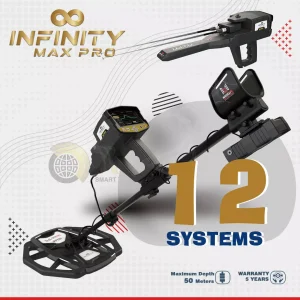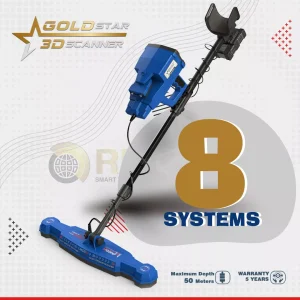Underwater Metal Detectors
Ever wondered what mysteries lie beneath the ocean floor, waiting to be uncovered? For avid scuba divers seeking an added dimension of thrill and adventure, the answer might just be hidden treasures waiting to be discovered with underwater metal detectors.
In this comprehensive guide, I will delve into the realm of underwater metal detectors—a tool that not only unlocks the potential for uncovering submerged artifacts but also elevates your diving experience.
From understanding their critical features to finding the best detector for your diving needs, this guide will help you get started. Already own an underwater metal detector? Read on to learn how to safely get the best performance out of your detecting equipment.
Historically, underwater metal detectors are responsible for some of the biggest and most famous treasures ever found. The Atocha spanish ship wreck for example had 24 tons of silver and 125 gold bars on board when it sank in 1622. The Atocha was found later in 1985 . That treasure today would be worth about US$1Billion and there are even bigger treasures still out there!
What is an Underwater Metal Detector?
An underwater metal detector is a specialized device designed to detect metallic objects submerged beneath the sea floor. They can play a crucial role in various diving activities, including wreck discovery, underwater archeology, treasure hunting, and search and recovery.
These detectors are waterproof and built to withstand the conditions of aquatic environments, allowing divers and enthusiasts to locate metal objects such as jewelry, artifacts, or other submerged treasures.
Underwater metal detectors operate on different technologies, including Pulse Induction (PI) and Very Low-Frequency (VLF), each with its advantages and applications. They provide visual, audible, or vibration alerts to signal the presence of metal underwater, enhancing the user’s ability to explore and discover objects hidden beneath the ocean floor.
Types of Underwater Metal Detectors
There are two main types of underwater metal detectors, each utilizing distinct technologies:
- Pulse Induction (PI) Metal Detectors:
- Technology: PI detectors generate short bursts of electrical current, creating magnetic fields. When the pulse is turned off, the magnetic field collapses, inducing a voltage spike. Metal objects disrupt this process, producing a distinctive signal.
- Advantages: Excellent depth penetration, making them ideal for deep-ground and highly mineralized soil conditions.
- Drawbacks: Limited discrimination capabilities, making it challenging to differentiate between types of metals.
- Very Low-Frequency (VLF) Metal Detectors:
- Technology: VLF detectors operate by transmitting and receiving continuous low-frequency signals. Changes in the magnetic field caused by metallic objects generate audio signals.
- Advantages: Better discrimination capabilities, allowing users to identify specific metals. Suitable for various underwater environments.
- Drawbacks: Reduced depth performance compared to PI detectors.
Multifrequency Metal Detectors
Multifrequency metal detectors, also known as simultaneous multifrequency detectors, utilize advanced technology to operate on multiple frequencies simultaneously. Unlike single-frequency VLF detectors, multifrequency detectors can transmit and receive signals across a range of frequencies concurrently.
Signal Interference in Underwater Metal Detectors
Mineralization and Saltwater Conductivity
Mineralization and saltwater conductivity are factors that affect underwater metal detector performance.
- Mineralization: In underwater contexts, mineralization refers to the presence of various minerals in the seabed or soil.
- These minerals, such as iron and magnesium, can disrupt the electromagnetic signals emitted by metal detectors.
- It essentially introduces a layer of “background noise” that can interfere with the detector’s ability to discern specific metal signatures.
- Conductive Saltwater: The salts in seawater enhance its conductivity, posing a challenge for metal detectors.
- As your detector emits signals, the conductive nature of saltwater can cause these signals to scatter and distort, affecting the accuracy of the detection process.
In short, highly mineralized environments and saltwater can disrupt electromagnetic signals. When your detector sends out signals to locate metal objects, these minerals and conductive properties can interfere, creating noise and making it challenging to distinguish between the signals emitted by the detector and those bounced back from metal objects.
Waterproof VS Underwater Metal Detectors
Many people think that any ‘waterproof metal detector’ would make a suitable ‘underwater metal detector’ however, this isn’t the case and we’ll explain why now. In some cases these ‘waterproof’ detectors are simply rain proof, can be washed down, or handle the occasional dunking… but these are not the kind of detectors we are here to talk about today. A dedicated underwater metal detector is one that will give you a serious shot at finding coins, rings and treasure in a variety of underwater conditions and will stand the test of time.
There are actually a few very unique characteristics that set underwater metal detectors apart from everyday waterproof detectors! These special attributes are why true underwater detectors work well in both saltwater and freshwater environments, from depths of just a few feet to a few hundred feet. It’s also why they are responsible for finding more treasure than any other type of metal detector in the world.
Minelab CTX 3030
This is a super cool, fancy and sophisticated instrument, that was released in year 2012, but it still stays in some of the top positions in the niche. One of its main features is high quality discrimination which makes this item universal and suitable for any type of search, both underwater and on the seashore, plus it performs good when searching for coins. In other words, generally it is good for all types of detecting.
This item would have been in the top of our list if it could be submerged deeper than 3 feet , The machine offers a bunch of features. It provides big multicolor display, has GPS navigation built-in, new type of coil, and also wireless headphones. The design of the item is well-developed and the upper part of the shaft with the screen works as a counterbalance to the coil, preventing the user from physical fatigue.
The instrument can be fully submerged; in the niche of submersible tools, this is already a standard. But its GPS navigation feature is extremely convenient, since the user sees the route directly on the screen and can operate more efficiently, saving time and effort. This machine also shows seamless performance on the ground, so can be used for various locations.
Minelab Equinox 800
Another Minelab instrument, a bit lower in our review, but still showing decent quality. Here are the main technical specifications Equinox 800 is a professional device, all-purpose but good for wet conditions and seashore search. Multifrequency tool is equipped with a DD coil, four search modes, plus pinpoint regime. Ground balance can be set automatic or manually adjusted. The weight is moderate, 2,95 lbs.
The tool adapts well to various weather, and also different soils; it shows unexpectedly good results on wet soils, specifically on the seashore. Although the tool is not for underwater search, it manages to discriminate objects in the salt water well.
The kit can be enriched by wireless headphones and different additional accessories you have to buy separately. To conclude, Minelab Equinox 800 is a very proper instrument suitable for seashore search. If you are not going to dive for treasure hunting, and don’t want to waste money on expensive models, this one is a nice choice.
Garrett AT Max
Now we don’t have to tell you Garrett is cool, do we? AT MAX is also cool. Its tech specifications are: all-terrain professional single-frequency tool, the frequency is rather high 13,6 kHz, DD coil, four search modes plus pinpoint mode. The user is able to set the ground balance automatically or manually; the machine is powered by four AA batteries. The weight is average, 3 lbs.
The depth of reach this item offers is impressive, up to nine feet, without losing discrimination and clarity of signal. The operation frequency is universal and very flexible, enabling the tool to react comprehensively to objects of all sizes. Wireless headphones, large and convenient display and tap lights add to the user experience. Garrett AT Max is good for seashore search, so we really recommend it as a decent option for treasure hunting.
Nokta Anfibio Multi
The Nokta Anfibio Multi is the pledge of love of two Turkish brands, Nokta and Makro. So, the whole lineage title is Nokta Makro Anfibio Multi. This new brand has not yet gathered a lot of comments, but the comments we researched is pretty positive, and with time, this brand and its series promise to become some of the top in the industry.
Nokta Anfibio Multi has three frequencies for operation; the user can use one frequency at a time, to there is no multifrequency option. Yet, the device works well on the seashore and in salt water. Some of the benefits here are connected to design – the coil cable is placed around the shaft enabling the user to replace it; the handle and the armrest meet ergonomic requirements.
You will enjoy as many as nine (!) search modes and underwater performance on the depth of up to 16,4 feet. The item has additional fancy and handy features like wireless headset, vibration, tap lights, and built-in battery.
Makro Multi Kruzer
The last but not the list is an item by Makro. Multi Kruzer is a professional level single frequency device with six search modes. Pinpoint mode and special Deep mode make search very accurate with this machine. Ground balance can be automatic, manual, or tracking the conditions.
It functions underwater on the depth of up to 16,4 feet. The price is also moderate. The reason why Multi Kruzer is the last item in the list is its pretty humble performance underwater. It is cool, but nothing really special for that price. Also, the model does not have enough comments from customers to assess its functionality objectively.
As it becomes clear after checking out the rating, it is pretty easy to opt for a suitable metal detector for underwater or seashore treasure hunting, because the majority of models have their specific features that make them different from other products.
Eventually, it all comes down to the user – the skills and experience, potential targets, potential locations, the frequency of search sessions , will it make sense to buy an expensive tool for one or two sessions per year?, and so on. Each tool is good enough to invest into it, but some may suit each case better than others, therefore, all you need to do is know what is needed, and what model provides it.
Consider your particular case and preferences, define the budget, and take advantage of our rating and lists to purchase the most suitable submersible or beach machine for successful and fruitful treasure hunting!



